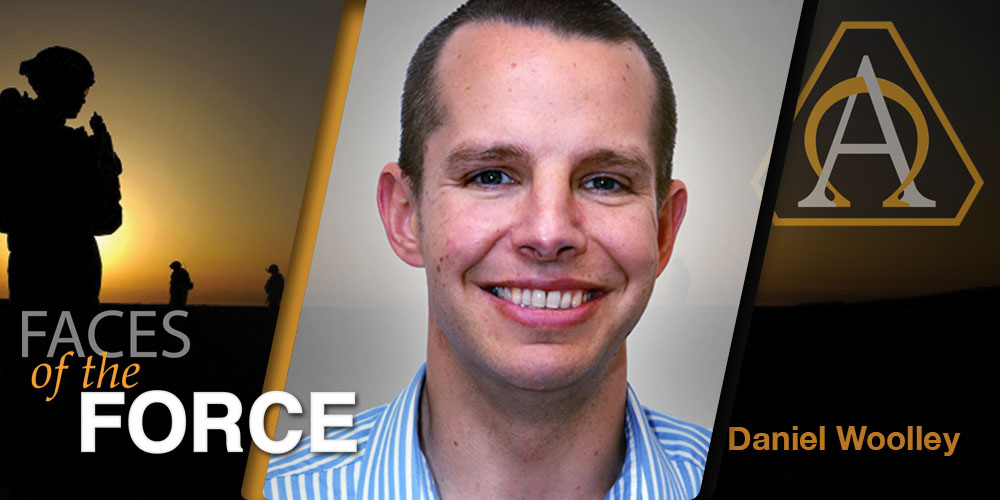
Faces of the Force: Daniel Woolley
POSITION: Chief Architect, Project Manager Mission Command
UNIT: Program Executive Office for Command, Control and Communications-Tactical, Aberdeen, Maryland
TOTAL YEARS OF SERVICE: 8
AWARDS: Superior Civilian Service Award, Superior Unit Award, Certificate of Commendation
EDUCATION: B.S. Mathematics and Computer Science, M.S. Software Engineering, and M.S. Computer Science; Monmouth University, New Jersey
By Sue Follett
Several years ago, Daniel Woolley worked as a software engineer at a major defense contractor while attending graduate school. That work brought him into contact with a lot of dedicated individuals, and ultimately led him to his current role of chief architect at PEO C3T’s Project Manager (PM) Mission Command.
“I met a lot of interesting and intelligent people during that time, and saw how dedicated they were to supporting the warfighter,” said Woolley. “I was struck by the fact that they spent a lot of time traveling away from their families and into harm’s way.”
He’s been in his current role with PM Mission Command for two years, and his work means dealing with a lot of different perspectives from a range of stakeholders. “My goal is to synthesize those viewpoints into something that can be executed and simply explained to others,” he said. “I try to ask a lot of questions when I can. Otherwise, I try thinking from the other stakeholder’s perspective and how decisions affect them. Then, I try to put those concepts into terms that the stakeholders understand.”
He noted that uncertainty is the biggest challenge of them all. “We’re trying to anticipate the Soldier’s needs in the 2020s, and to efficiently build an affordable foundation for the future. For PM Mission Command, this is basically figuring out how to enable operational adaptability: the ability to be agile and effective at warfare in an increasingly complicated environment. Our goal is improve the products to benefit the Soldier and at the same time be responsible to the nation.”

Woolley, chief architect at PEO C3T’s PM Mission Command, rolls a different way. Instead of a chair, Woolley does his best work on a ball, citing that it also helps with his posture. (U.S. Army photos by Chris Rosario)
FOTF: What do you do in the Army?
WOOLLEY: I plan for technology investments that will lead to the next generation of mission command software and hardware capabilities that will provide warfighters with an intuitive interface, access to data and services they need and flexibility to adapt to any mission.
For instance, we are currently part of a team that is developing the Command Post Computing Environment (CP CE), a set of computing environments that are enabling us to deploy web-based warfighting apps that can be displayed onto a single common operating picture, greatly enhancing the commander’s situational awareness.
One of the technical challenges we face with the CP CE is developing a system of systems solution as a community, which is a substantial change from the conventional method of developing a single system. From an acquisition viewpoint, the big challenge is partnering with multiple project and product managers to accomplish a broad goal.
The acquisition challenges may be more difficult because there is more cultural change involved. However, both challenges come with the opportunity to do things better for the Soldier and taxpayer: simplifying the systems in the CP CE, improving interoperability and collaboration, and reducing duplicative infrastructure development. Focusing on the positive aspects allows us to see the benefits of what we’re doing and work to overcome the obstacles.
FOTF: What has your experience been like?
WOOLLEY: It has been a great experience, and I enjoy working for the Army. I have been most surprised by the talented and interesting people — civilian, military and contractor — who support the Army. They put in great effort to accomplish their goals, specifically during the annual Network Integration Evaluations (NIEs).
The NIEs are a series of semi-annual field exercises designed to evaluate emerging communications technologies in a realistic operational environment. We work closely with the Soldiers and gather their feedback to ensure we are building the capabilities that are intuitive and effective to support their missions.
FOTF: What is your greatest satisfaction in being part of the Army?
WOOLLEY: I joined the Army as a civilian about eight years ago, for two reasons: to give back to the United States for all the opportunities it provides for its citizens, and I think I can make a difference. My greatest satisfaction is working on products that save Soldiers’ lives and prevent collateral damage to the civilian population.
Related Links:
PEO C3T
Stand To! Network Modernization Roadmap, April 28, 2014
Army.mil – Apps on Map link the Command Post, Mounted and Dismounted Soldiers
- “Faces of the Force” is an online feature highlighting members of the Army Acquisition Workforce. Produced by the U.S. Army Acquisition Support Center Communication Division, and working closely with public affairs officers, Soldiers and Civilians currently serving in a variety of AL&T disciplines. For more information, or to nominate someone, please contact 703-805-1006.







